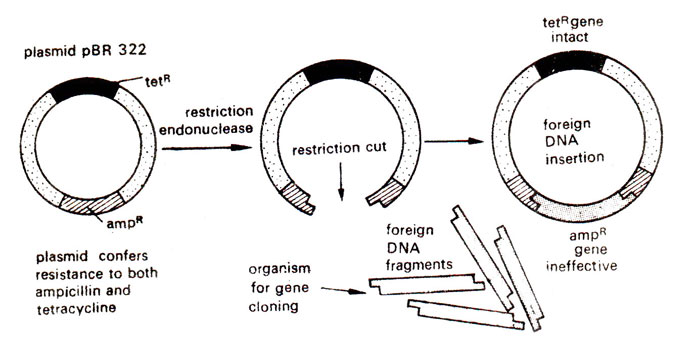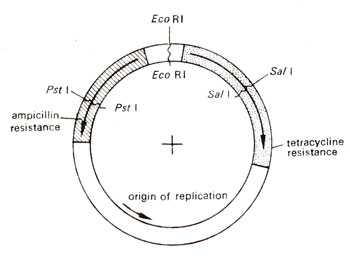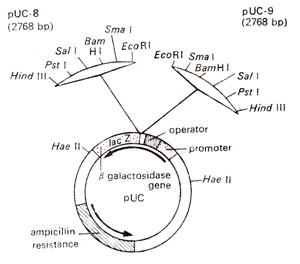Plasmids as vectors
Plasmids are defined as autonomous elements, whose genomes exist in the cell as extrachromosomal units (see Plasmids, IS Elements, Transposons and Retroelements). These plasmids can be single copy plasmids that are maintained as one plasmid DNA per host chromosome or multicopy plasmids, which are under relaxed replication control, thus permitting their accumulation in very large numbers (upto 1000 copies per cell). These latter type of plasmids are used as cloning vectors, due to their increased yield potential.
Circular plasmid DNA which is used as a vector, can be cleaved at one site with the help of an enzyme to give a linear DNA molecule. A foreign DNA segment can now be inserted, by joining the ends of broken circular DNA to the two ends of foreign DNA, thus regenerating a bigger circular DNA molecule that can now be separated by gel electrophoresis on the basis of its size (Fig. 39.6). Selection of chimeric DNA is also facilitated by the resistance genes which the plasmid may carry against a certain antibiotic. If a plasmid has two such genes conferring resistance against two antibiotics and if the foreign DNA insertion site lies within one of these two genes, then the chimeric vector loses resistance against one antibiotic, the gene for which has foreign DNA inserted within its structure. In such a situation, the parent vector in bacterial cells can be selected by resistance against two antibiotics and the chimeric DNA can be selected by retention of resistance against only one of the two antibiotics.
The naturally occurring plasmids may not possess all the above and other essential properties of a suitable cloning vector. Therefore one may have to restructure them by inserting genes of relaxed replication and/or genes for antibiotic resistance. This has actually been done and suitable plasmid vectors have been obtained. Following are some popular examples.
pBR322 and pUC vectors. One of the standard cloning vectors widely used in gene cloning experiments is pBR322 (derived from E. coli plasmid ColEl), which is 4,362 bp DNA and was derived by several alterations in earlier cloning vectors (Fig. 39.7). Another series of plasmids that are used as cloning vectors belong to pUC series (after the place of their initial preparation i.e. University of California). These cloning vectors are available in pairs with reversed orders of restriction sites relative to lac Z promoter; pUC 8 and pUC 9 make one such pair (Fig. 39.8). As discussed above, in pBR322, the DNA is inserted at a site located in one of the two genes for resistance against antibiotics, so that it will inactivate one of the two resistance genes. The insert bearing plasmid can be selected by their ability to grow in a medium containing only one of the two antibiotics and by their failure to grow in a medium containing both the antibiotics. The plasmids carrying no insert on the other hand, will be able to grow in media containing one or both the antibiotics. In this manner, the presence of lac Z gene in pUC and resistance genes against ampicillin and tetracycline in pBR322 allow selection of E. coli colonies transformed with plasmids carrying the desired foreign cloned DNA segment.
Ti plasmid as a vector for higher plants. Among higher plants, Ti plasmid of Agrobacterium tumefaciens and Ri plasmid of .4. rhizogenes are the best known vectors. T-DNA, from Ti or Ri plasmid of Agrobacterium, is considered to be a very potential vector for cloning experiments with higher plants. This will involve the following steps : (i) foreign DNA has to be first cloned into T-DNA of Ti or Ri plasmid, (ii) modified hybrid T-DNA can be transferred to the genome of plant cells by Agrobacterium infection. Recombinant Ti plasmids can also be obtained by cloning of a large fragment of Ti plasmid in pBR322. These recombinant Ti plasmids can then be used for transformation of higher plants (consult Genetic Engineering and Biotechnology 4. Gene Transfer Methods and Transgenic Organisms).
The naturally occurring plasmids may not possess all the above and other essential properties of a suitable cloning vector. Therefore one may have to restructure them by inserting genes of relaxed replication and/or genes for antibiotic resistance. This has actually been done and suitable plasmid vectors have been obtained. Following are some popular examples.







